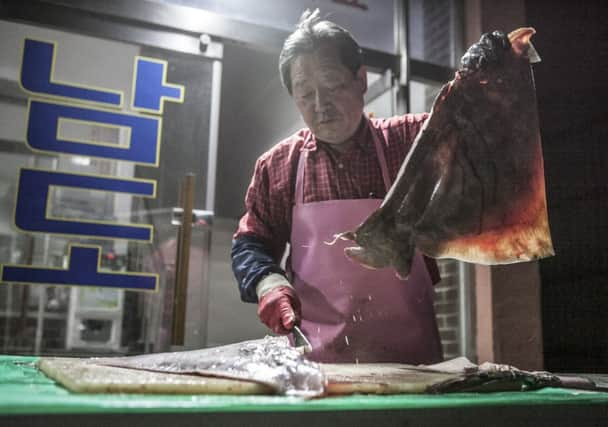Ammonia tang of hongeo fish gains recognition


But fermented skate from the southern island tops them all.
By far South Korea’s smelliest food, the fish – called hongeo – is described by lovers and detractors alike as releasing odours reminiscent of an outhouse.
Advertisement
Hide AdAdvertisement
Hide AdUsually served as chewy pink slabs of sashimi, hongeo is prized for the ammonia it releases – sometimes so strong it peels diners’ mouths.
“I used to think that people could not possibly eat this stuff unless they were crazy,” said Park Jae-hee, 48, a marketing executive. “But like smelly blue cheese, it has no replacement once you fall in love with it.”
It is easy, of course, to poke fun at other nations’ cuisines. But even South Koreans who are otherwise fiercely proud of their fiery, often odiferous foods, such as kimchi, admit to being repelled by hongeo and baffled by its rising popularity.
Even those who salivate over its exotic taste cheerily admit their passion comes with some social costs.
A subway ride after a meal of hongeo can be isolating, with other passengers sometimes casting furtive glances and sidling away. Restaurateurs advise customers to seal their jackets in plastic bags before the meal and spray them with deodorant afterwards.
“I’ve eaten dog, durian and bugs, but this is still the most challenging food I’ve ever eaten,” said American Joe McPherson, the founder of the Korean food blog ZenKimchi. “It’s like licking a urinal.”
The lowly fish, once just a regional speciality in the south-west provinces of North and South Jeolla, followed the migration of rural workers during South Korea’s industrial boom in the 20th century, with restaurants specialising in hongeo opening to serve growing populations of scattered Jeolla natives.
Among the legions of the fish’s fans, the velvety texture of frozen hongeo liver melting on the tongue with a pinch of salt and red pepper has been compared to foie gras.
Advertisement
Hide AdAdvertisement
Hide AdThe smell, say aficionados, is most of the appeal, coupled with a tingling in the mouth that accompanies the hit of ammonia.
Despite the dish’s newfound popularity, the centre of hongeo worship remains Heuksan Island, off the country’s south-western tip.
Islanders say the fish first gained a following here because of a quirk of biology. The hongeo lacks a bladder and excretes uric acid through its skin. As it ferments, it oozes ammonia that keeps it from going off.
The fish has also helped rejuvenate this island of 2,200, once a major port, where thousands of boats sought shelter from typhoons and where crews traded in fish and visited the then-famous bars.
Yoon Sung-jong, 51, the island’s postmaster, said that up to 80 per cent of the outbound packages his office handled were hongeo, addressed to mainland restaurants, where a dish of Heuksan Island’s hongeo can go for $150 (£90).
But hongeo has also helped bridge regional prejudices.
Some Gyeongsang natives have been drawn to Heuksan Island to sample the fish. In a goodwill gesture in 2005, Park Geun-hye, a Gyeongsang native and aspiring president, sent two hongeo as a gift when a Jeolla politician named Han Hwa-gap was elected head of an opposition party.
When Han switched his allegiance to support Park’s bid for the presidency – earning death threats – he cited how touched he had been by the symbolism of her gift.